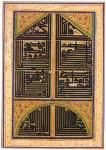| India, 15th century |
 |
 |
 |
Qur'an Page
Ink, gouache and gold on paper
Binding in embossed and gilt leather
22 x 10 1/4 in.
Geneva, Jean-Paul Croisier collection.
Sotheby's (1978), 6, p. 6. |
 |
| A page from a Qur'an of slightly unusual long, narrow format. It contains the end of Surah XXVII, an-Naml, The Ants, verses 92-93 and the beginning of Surah XXVIII, Al-Qasas, The Narration, verses 14. The text is in black Bihari script (sometimes written in Bihari) which is characteristic of Indian Qur'ans in the 14th and 15th centuries. The letters are distinguished by the strangely uneven quality of certain horizontal strokes, particularly at the end of a word, which are elongated, thickened and then tapered to a sword-like point. The name Allah, whenever it appears, is written in gold. Vowels are in the form of horizontal strokes, whereas they are written at an angle of 45 degrees in most cursive scripts. Bihari was used mainly for transcribing copies of the Qur'an. It was peculiar to India in the same way that Maghrib was to North Africa. The latter, however, has survived until the present day, whereas Bihari had virtually disappeared in India by the 16th century. Nevertheless, it was still used occasionally to copy out Qur'ans, as a manuscript produced in the late 16th century shows (India Office Library, London, 1035).
The blue medallion on the right bears the Arabic letter 'ayn, which stands for the word ruku'. Each Surah (chapter) was divided into several ruku' (parts)and the medallion means that the final ruku' of Surah XXVII is now complete. Just below the medallion is the illuminated heading of Surah XXVIII. |
|
| India, Agra, 1651 AD |
 |
 |
 |
Chased brass seal with ebony handle
Ink gouache and gold on paper
Diam 1 3/4 in, Length 4 1/4 in
Dublin, private collection.
London (1982), 514, p. 153 |
 |
This finely engraved seal, cast in brass, bears the date 1062 (1651 AD) and the inscription reads:
Shihab al-Din, Mohammed Shah Jahan Padshah Ghazi.
It is a seal of the Mughal Emperor of Muslim India, Shah Jahan (1627-1628). The ebony handle is perhaps a modern addition, but the style of calligraphy, arabesque decoration and layout, is typical of 17th century Indian Mughal seals. Seals were made of metal or hard stones like carnelian. Islamic documents were always sealed with ink. The seal was moistened, dipped in ink and then pressed onto the document. Wax was almost never used in Islamic countries, as it was in Europe, to make a seal impression. |
|
| Probably India, 18th - 19th century |
 |
 |
 |
Ink and gouache on paper stuck on cardboard.
10 x 6 1/4 in
Riyadh, Rifaat Sheikh El-Ard collection.
Sotheby's (1980 b), lot 181, p. 86. |
 |
This talisman written in heavily stylized Kufic script makes a particularly striking and powerful impression. Similar to a mihrab in shape, it is made up of three separate parts. At the top and bottom are triangular and semi-circular panels bearing standard formulae used amongst other things for warding off evil. The four central panels contain the Surah LXVIII, Al-Qalam, The Pen, verses 51- 52:
"And the unbelievers
Would almost trip thee up
With their eyes when they Hear the Message; and they
Say: Surely he is possessed
But it is nothing less
Than a Message
To all the worlds."
Although these verses were not often used as a talisman, their references to the eyes of evil men, madness and possession, would seem to render them appropriate. The one the unbelievers describe as being "mad" and "possessed" is Muhammad himself. The "Message" he was bringing was of course the Qur'an, the antithesis of madness and regarded by Muslims as the cure for all evil. This probably explains the choice of these two verses as a talisman. At least two other versions of this composition are known, but this is the only one to have floral decoration. Like many talismans, this one was probably intended to prevent or even cure a specific evil, though it is not clear which one. |
 |
|
|

